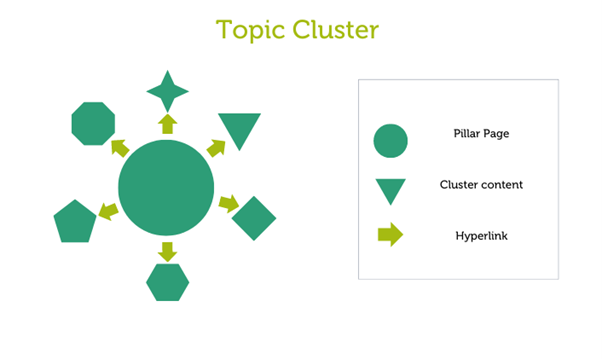In the ever-evolving world of search engine optimisation (SEO), staying ahead of the game is crucial. And when it comes to SEO tools, HubSpot has been a long-standing favorite for many B2B marketers. It’s a CRM with bite, and that bite comes from the many tools available, and able to be used directly by the people who need them – marketing managers.
Today, we're going to dive into the exciting realm of HubSpot's Topic Cluster tool and how it can help you level up your B2B SEO efforts. So, grab a cup of coffee and get ready to revolutionise your content strategy!
What Makes HubSpot's Topic Cluster Tool Special?
Before we dive into the intricacies of HubSpot's Topic Cluster tool, let's quickly understand what topic clusters are about. In simple terms, topic clusters are a content organisation strategy that revolves around one core topic and its related subtopics. The age-old adage that content is king, still rings true.
This approach helps search engines recognise the relevance and depth of your content, ultimately boosting your website's visibility and ranking. In short, it’s a unique, focused, and underused search technique, and we think it’s the secret weapon of B2B marketers

With the HubSpot Topic Cluster tool, B2B marketers can plan, create, and optimise their content strategy. They can also do it all within the HubSpot portal, making it a truly convenient one-stop solution. This eliminates the need for juggling multiple platforms and streamlines your workflow. Will it save time? Absolutely, but it also ensures consistency across all marketing efforts which builds trust and credibility in a business.
Key advantages of Using HubSpot’s Topic Cluster tool
The tool is designed for marketing managers, whether you're a seasoned content strategist or just starting out, it’s intuitive and easy to navigate. The simplicity of the interface allows you to focus on what really matters – creating impactful content that drives results.
Another standout feature is the comprehensive planning capabilities. With HubSpot's Topic Cluster Tool, a marketing manager could effortlessly map out a content strategy and ensure that the content aligns with the overarching goals. The tool provides a bird's-eye view of the entire content landscape, allowing marketing managers to identify any gaps or opportunities that may exist.
In addition to the practical benefits, HubSpot's Topic Cluster Tool also offers valuable optimisation features. The tool provides insights and recommendations to help improve the visibility and searchability of B2B content.
From keyword suggestions to on-page optimisation tips, HubSpot is equipped with the tools needed to enhance content performance and drive more organic traffic to websites. Creating content is even easier with the new AI power Content Assistant. This snazzy addition makes content creation easier, and marketing managers can use it in the Blog, Email and Landing Pages marketing tools.
So, now you know what Topic Clusters are and why you’ll benefit from using the Topic Cluster tool in HubSpot, let’s explore what we at Angelfish think is the best way to leverage it.
Here's how YOU can leverage HubSpot's Topic Cluster tool to take your SEO efforts to new heights:
Identify Your Core Pillar Topic:
The first step in creating a successful content strategy is to identify a core pillar topic. This topic should be a broad theme or concept that is directly related to your business. It will serve as the foundation for your cluster of content, helping to establish your expertise and authority in your industry.
Explore Subtopics and Keywords:
Once you have identified a core pillar topic, it's time to dive into the world of keyword research and brainstorm relevant subtopics. This will help you understand the search terms and phrases that are popular within your industry and will guide your content creation process. Utilise tools like HubSpot's keyword research tool to discover related keywords and gauge their search volume. This will ensure that you are on the right track and targeting the right audience with your content.
Create Pillar and Cluster Content:
Armed with your core topic and subtopics, it's time to create content! Start by writing a comprehensive piece of content called the "pillar" page. This should be a detailed and informative piece that delves deep into your main topic, providing valuable insights and information for your readers. Then, create individual blog posts or articles for each subtopic, linking back to the pillar page. This will not only establish a strong internal link structure but also make it easier for readers to navigate through your content and find the information they are looking for. Use the AI power Content Assistant!
Internal and External Linking:
Linking is a crucial aspect of topic clusters. Within your cluster content, make sure to link back to the pillar page. This will help search engines understand the relationship between your content pieces and establish a strong internal link structure on your website. Additionally, consider reaching out to other websites or blogs in your industry and propose guest posts or collaborations. This will allow you to build external links and create valuable connections within your industry, boosting your SEO efforts and driving more traffic to your website.
Optimise and Monitor:
Once your content is created, don't forget to optimise it for search engines. Use tools like HubSpot's topic cluster tool to track your keyword rankings and identify areas of improvement. This will help you refine your content strategy over time and ensure that you are targeting the right keywords and topics. Additionally, keep a close eye on your analytics to measure the impact of your topic clusters on your website's visibility and organic traffic. This will help you understand what is working and what needs adjustment, allowing you to continuously improve and refine your content strategy.
Topic Clusters: The secret weapon for B2B inbound marketing
By following these steps and implementing a topic cluster strategy, you can establish your expertise, increase your visibility in search engines, and drive more organic traffic to your website. Remember to stay consistent with your content creation and optimisation efforts, and always keep an eye on the latest trends and developments in your industry.
Now you have a good grasp of how HubSpot's Topic Cluster tool can revolutionise your SEO game, it’s over to you. B2B SEO is a continuous process that requires experimentation and adaptation, and Topic Clusters are a unique and underused part of the process.
So, take advantage of this powerful HubSpot tool, develop compelling content, make sure everything is interlinked, and watch your website climb the search engine ladder!
Need help with your Topic Cluster research? We’re happy to guide you, reach out to one of our growth specialists and get ready to reap the rewards of effective inbound marketing!










